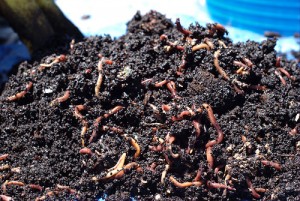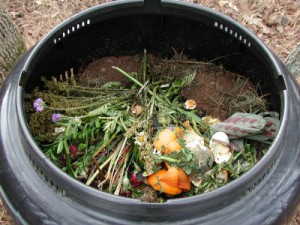It may sound like a daunting task, but it doesn’t have to be. Sure, you can buy a lot of expensive tools and containers for composting, but you can also do it easily and simply. What is compost? Is the result of combining things like grass clippings, leaves, scraps from vegetables and fruits, wood-chips, etc. and allowing them to break down until they become like soil. What you end up with is a product that makes your plants grow like gang-busters.
 Compost is not actually a fertilizer, although it sounds like that’s what it does. It acts more like a mulch in that it keeps things moist, it keeps weeds down and it acts like a protective blanket, keeping the soil cooler during the day and warmer during the night.
Compost is not actually a fertilizer, although it sounds like that’s what it does. It acts more like a mulch in that it keeps things moist, it keeps weeds down and it acts like a protective blanket, keeping the soil cooler during the day and warmer during the night.
We’ve already mentioned some things that are good for composting. But what should you avoid using? Don’t add meat scraps unless you want a new home for all the neighbourhood rodents. And don’t use kitty litter or dog poo. These things don’t break down like they need to and they can contain too many unsavoury substances.
When you decide you’re going to tackle composting, you can use a barrel or even just create a pile on the ground. It doesn’t even have to be turned regularly. What you do need to do is keep it covered with soil. That will prevent rodents and flies taking up residence. Another important factor is to keep a good balance of what goes into the compost.
 Things high in nitrogen are fresh, green plants, fresh grass clippings and most all of your kitchen scrap material. Things high in carbon are dried, brown plant material, washed eggshells, leaves, straw, and dried grass clippings. If you overdo one or the other, you won’t get the desired results. A good ratio is three parts carbon to one part nitrogen.
Things high in nitrogen are fresh, green plants, fresh grass clippings and most all of your kitchen scrap material. Things high in carbon are dried, brown plant material, washed eggshells, leaves, straw, and dried grass clippings. If you overdo one or the other, you won’t get the desired results. A good ratio is three parts carbon to one part nitrogen.
Keep the pile moist but not overly wet, you may need to protect it from heavy rains. If you cover it with a tarp, be sure to uncover it during the dry weather to let it breathe. You want it to be loose and aerated and should heat up to 160 degrees within days. You’ll turn it and alternately let it rest and allow the temperature to rise again. Repeat this process a few times over about six weeks. You’ll know it’s ready when it looks like rich black soil that crumbles easily.